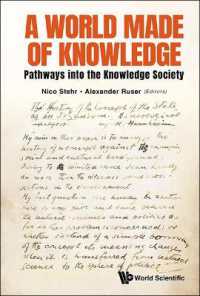Full Description
Cataloguing has always produced a catalogue, while the creation of metadata has produced the metadata of given resources. However, in this digital age, the two are more connected than ever. A catalogue is made up of metadata that can be searched, identified, structured and selected. This then means the metadata creation process is adopted as a part of cataloguing.
From Cataloguing to Metadata Creation is a cultural and methodological introduction to the evolution of cataloguing towards the metadata creation process in the digital era. It is a journey through the founding principles and the objectives of the 'information organisation' service that libraries offer. The book aims to outline the new library context, highlighting continuities and innovations compared to traditional cataloguing and intends to trace the path from traditional cataloguing to the new metadata creation process.
Contents
Prefaces (Barbara B. Tillett and Peter Lor)
Acknowledgments
List of Acronyms
1. Cataloguing and metadata. The centrality of a cultural and technical activity
2. Panta rei
2.1 Metanoia
2.2 New concepts and new terminology
2.3 Metadata: a polysemantic term
2.4 Libraries, Semantic Web and linked data: the data librarian
2.5 Metadata and bibliographic control
2.6 The importance of the catalogue
2.7 Two pitfalls for cataloguing and the catalogue?
2.8 How catalogues have to change to be of the Web and not just on the Web?
2.9 New discovery tools: data.bnf.fr
3. Principles and bibliographic models
3.1 Bibliographic models
3.2 Paris Principles
3.3 ICP
3.4 FRBR
3.5 FRAD
3.6 FRSAD
3.7 FRBRoo
3.8 IFLA LRM
3.9 Family of works
4. Description of resources
4.1 Description: a cultural and technical process
4.2 A new way to describe
4.3 Object of the description
4.4 Resource analysis: the bibliographic analysis
4.5 Sources of information
4.6 Main sources of information to describe a book
4.7 Types of description
4.8 Levels of description
5. Access to resources
5.1 Access: authority data
5.2 Relationships
5.3 Author and title
5.4 Authority control: authorised access point
5.5 Entity Identifiers
5.6 VIAF
5.7 ISNI
6. Exchange formats and description standards: MARC and ISBD
6.1 MARC, UNIMARC, MARC21
6.2 BIBFRAME
6.3 ISBD
6.4 ISBD: Consolidated Edition
6.5 ISBD: purposes
7. RDA: some basics
7.1 RDA
8. Subject Cataloguing (or subject indexing): some basics
8.1 A separate path
Concluding afterword (Giovanni Bergamin)
Notes
References
Index







